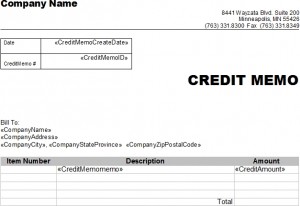 Credit memos are typically generated after an invoice has already been sent to a customer. These memos reflect error corrections. Credit memos serve as an invoice but reflect a negative amount. This negative amount is actually a credit that is owed to the customer.
Credit memos are typically generated after an invoice has already been sent to a customer. These memos reflect error corrections. Credit memos serve as an invoice but reflect a negative amount. This negative amount is actually a credit that is owed to the customer.
When a credit memo is generated there are typically two ways that the credit is handled. If the customer has other open invoices the credit may be applied toward those balances. If there are no open invoices, a refund check can be issued.
When formatting a credit memo you should divide it into three subdivisions; header, body, and footer. The header section of a credit memo should contain your company name and contact information along with the company’s Federal Employer Identification Number. It’s also important to put the words “CREDIT MEMO” at the top of your form.
The header should also include a serial number for the credit memo, similar to the format used for creating invoice numbers. Other items that should be in the header are the date, customer number, payment terms, original sale invoice number, and the customer’s name and billing address. Credit memo numbers make it easy to find the document in your computer system should the customer call with questions. If the customer is having a hard time locating the credit memo number using the date the memo was created or the customer number are other quick reference guides that assist in finding the document in your computer files. By including the original sales invoice number you have further documentation to research should the customer call with questions or concerns.
The body of your credit memo is where you explain the reason the memo was generated. There are many reasons credits are issued: Discounts that were applied after shipping and invoicing, customer returned an item, customer was overcharged for a product or service, or shipping was incomplete and the customer never received their order. Be as descriptive as you possibly can in the body of your document. Reference the original invoice number again and point out any pertinent information that caused the credit from the original invoice. Detailed information should be described in this section of your memo, such as credit given for a returned and received item, listing of the correct price the customer should have been charged, and the net amount of the credit being given to the customer.
Finally, your memo should include a footer. The footer serves as a window that details all of the financial aspects of the credit memo in a quick glance. It itemizes total amounts of credited items, amount of sales tax due to customer for the credited amount, and the total credit amount after tax and credit amount are added together. You can also add notes to the customer in the footer section.
If you are a business owner and you send invoices to your customers for products or services rendered, situations will arise where you have to create a credit memo to correct an error. Credit memos are important documents and must be accounted for in a business’s financials to insure smooth business operations. There are programs available for creating credit memos but you can always manually generate them. Just be mindful when manually creating a credit memo to reduce your net income amount.